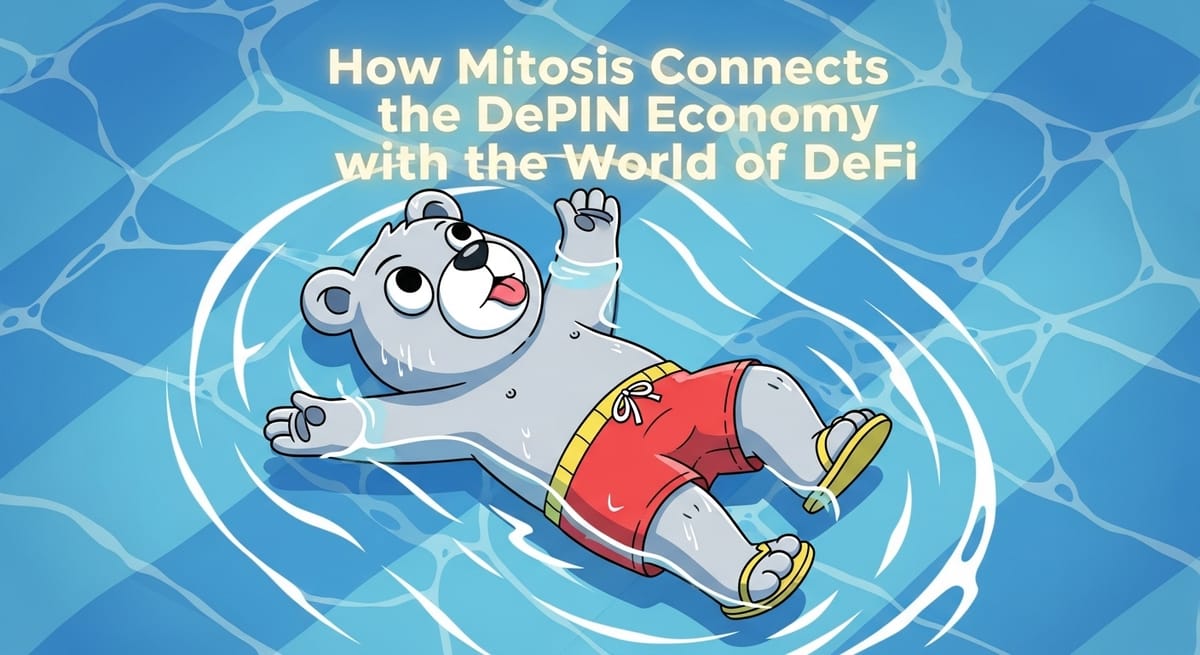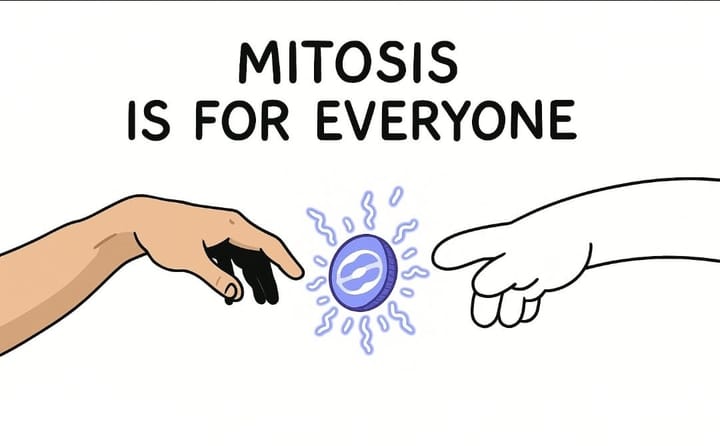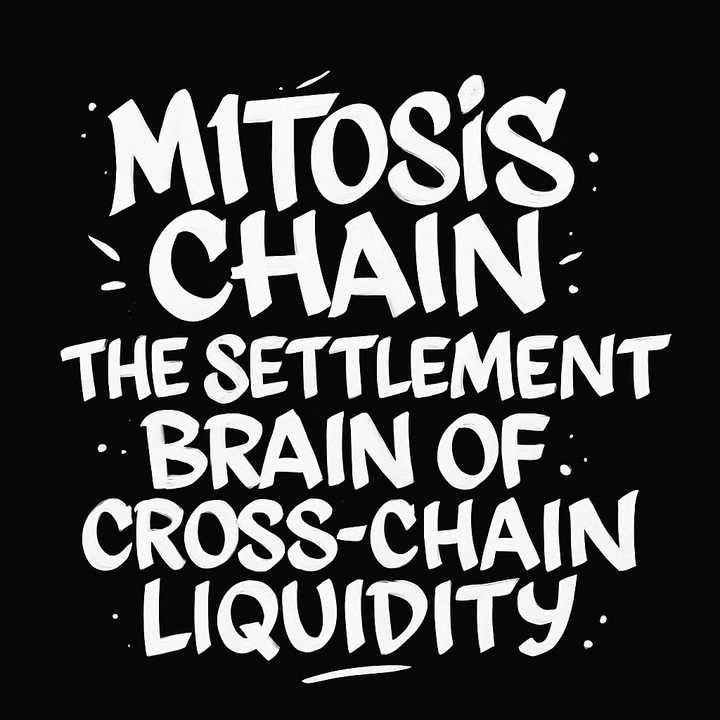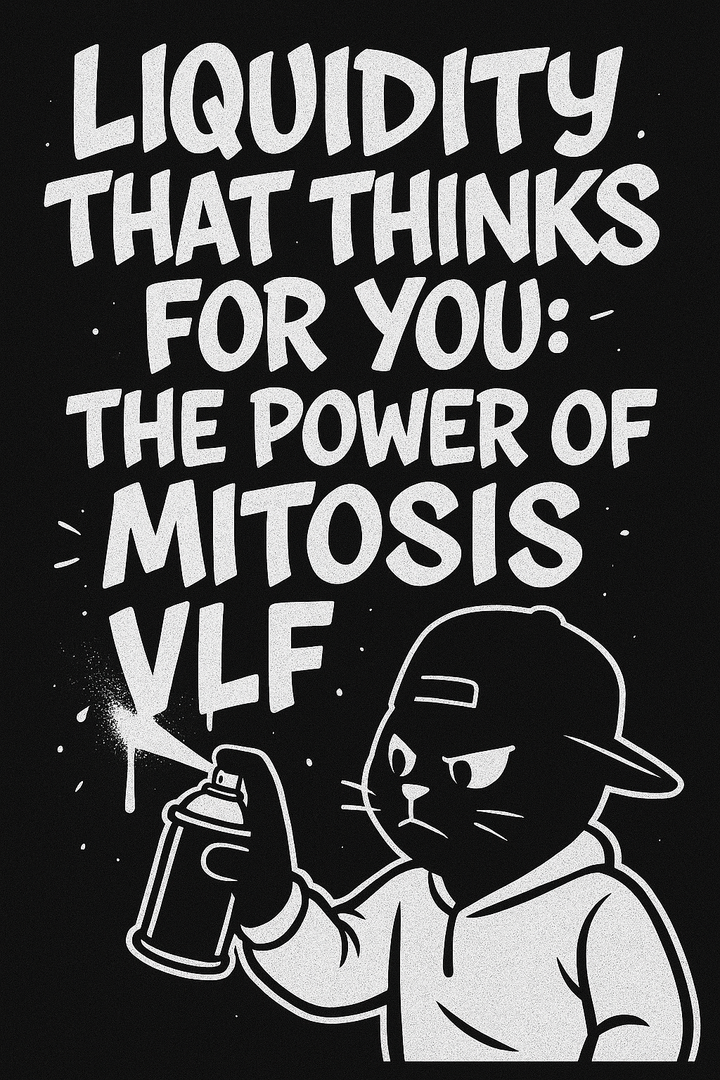From WiFi to GPUs: How Mitosis Connects the DePIN Economy with the World of DeFi

1. Introduction: DePIN – The Next Great Web3 Revolution?
In recent years, the Web3 space has given us decentralized finance (DeFi) and non-fungible tokens (NFTs). But now, a new, potentially even larger revolution is rising on the horizon – DePIN, or Decentralized Physical Infrastructure Networks.
What is DePIN? In simple terms, these are blockchain networks that use tokens to incentivize people around the world to collaboratively build and manage real-world physical infrastructure.
Examples of DePIN networks:
- Wireless Networks: Projects like Helium, where people install hotspots in their homes and earn token rewards for providing coverage for IoT devices or 5G.
- Data Storage: Networks such as Filecoin or Arweave, where users rent out free space on their hard drives and receive tokens for storing files.
- Compute Power (GPUs): Projects like Render Network, where owners of powerful graphics cards can provide their computing resources for rendering graphics or training AI models in exchange for tokens.
- Data Collection: Networks of sensors collecting data on weather, traffic, or air quality, where sensor owners are rewarded with tokens.
DePIN is a powerful concept that allows for the construction of global infrastructure more efficiently, democratically, and cheaply than centralized corporations can. This sector has already attracted billions of dollars in capital and has the potential to transform entire industries.
The Liquidity Problem in the World of DePIN
Despite its enormous potential, the DePIN ecosystem faces a serious economic problem that is holding back its growth. Participants in these networks (e.g., a Helium hotspot owner or a Filecoin miner) receive rewards in the native tokens of these networks (HNT, FIL, etc.). And here, several difficulties arise:
- Isolated Liquidity: Trading for these DePIN tokens is often concentrated on a few centralized exchanges or on DEXs within their own, often illiquid, ecosystems.
- Difficulty of Use in DeFi: It is very difficult for a DePIN token holder to use them in the thriving world of DeFi on Ethereum, L2 networks, or Solana. How can one use earned FIL as collateral in Aave? How to provide liquidity for HNT on Uniswap?
- Barriers for Participants: The need to deal with complex processes of withdrawing tokens to exchanges, swapping, and transferring to other networks deters many potential participants from joining DePIN networks.
This liquidity fragmentation creates a barrier between the DePIN economy, which is based on real physical work, and the highly liquid, opportunity-rich world of DeFi.
Mitosis: The Bridge Between the Physical and Digital Economies
This is precisely the problem that Mitosis is designed to solve. As a protocol specializing in the secure and efficient movement of liquidity between any networks, Mitosis can become the critically important bridge that connects the DePIN economy with the global DeFi market.
How can Mitosis help the DePIN ecosystem?
- Providing an "Exit Ramp" to DeFi: Offering a simple and secure way for DePIN network participants to move their earned tokens to major DeFi ecosystems (Ethereum, Arbitrum, Polygon, etc.).
- Creating Liquidity: Mitosis's EOL model can be used to create initial liquidity for DePIN tokens on popular DEXs in EVM chains, making them more accessible for trading.
- Attracting Capital to DePIN: By simplifying swaps, Mitosis makes it easier for DeFi investors to buy DePIN tokens, thereby funding and supporting the growth of these physical infrastructure networks.
What Will You Learn From This Article?
In this article, we will explore in detail how Mitosis can be a catalyst for the next wave of growth in the DePIN sector:
- We will analyze how Mitosis solves the key liquidity problems for DePIN tokens.
- We will look at specific scenarios of how a Helium or Filecoin user could use Mitosis to integrate into the world of DeFi.
- We will discuss why the synergy between DePIN and cross-chain liquidity protocols like Mitosis is important for the future of the entire Web3 industry.
We will show that Mitosis is not just a bridge for financial assets, but a fundamental infrastructure capable of connecting the growing real-world-based economy with the limitless possibilities of decentralized finance.
2. Mitosis in Action: Opening DeFi Gateways for the DePIN Economy
Having examined the liquidity challenges in the DePIN sector, let's delve into the specific scenarios made possible by Mitosis and assess the strategic importance of this synergy.
Scenario 1: A DePIN Contributor Wants to Realize Profits and Diversify
Imagine Bob. He has set up several devices at home for a decentralized data storage network and has earned 100 X tokens (the native token of this DePIN network) in a month. The X network has its own L1 blockchain.
- Bob's Problem: He wants to sell 50 X tokens to cover electricity costs and invest the other 50 X tokens in something more stable, like staking ETH via Lido (stETH) on the Ethereum network. Without Mitosis, he would have to:
- Find a centralized exchange (CEX) that lists the X token.
- Transfer the X tokens from his wallet to the exchange.
- Sell 100 X for USDC or ETH.
- Withdraw 50 USDC to his bank account.
- Withdraw the remaining ETH to his Ethereum wallet and swap it for stETH.
This is a long, complicated process that requires trusting a CEX.
- The Solution with Mitosis:
- Bob uses a dApp integrated with Mitosis.
- He initiates a cross-chain transfer: "Send 100 X tokens from the X network."
- As the destination, he can choose several options:
- "Receive 50 USDC on the Polygon network" (for cheap fiat off-ramping).
- "Receive stETH worth 50 X tokens on the Ethereum network."
- Mitosis handles all the complex work "under the hood":
The Result: Bob easily and securely diversifies his DePIN earnings, directly integrating into the DeFi economy without needing to use centralized intermediaries.
Scenario 2: A DeFi Investor Wants to Invest in DePIN's Growth
Now imagine Alice. She is an experienced DeFi investor, and her capital is in stablecoins on the Arbitrum network. She has read research about the promise of DePIN network Y and wants to buy its native Y tokens to support the network and profit from its growth.
- Alice's Problem: Y tokens are mainly traded on a DEX within their own L1 network. Alice would have to go through a complicated process to buy them.
- The Solution with Mitosis:
- Alice uses a cross-chain aggregator built on Mitosis.
- She creates an order: "Swap 10,000 USDC from Arbitrum for Y tokens on the Y network."
- Mitosis provides a seamless transfer of her USDC to the Y network (or an intermediary chain with liquidity) and executes the purchase of Y tokens.
- The Y tokens are credited to Alice's wallet on the Y network.
The Result: DeFi capital flows easily into promising DePIN projects, accelerating their growth and development. Mitosis becomes a key "investment bridge" between these ecosystems.
The Strategic Importance of the DePIN and Mitosis Synergy
This interconnection benefits all participants and creates a powerful growth cycle:
- For DePIN Projects:
- Capital Inflow: Easy access for DeFi investors means more capital for network development.
- Contributor Attraction: The ability to easily use and sell earned tokens makes participating in a DePIN network more attractive to ordinary people.
- Increased Token Utility: Integration with DeFi turns a DePIN project's native token from a simple "reward" into a full-fledged financial asset.
- For the Mitosis Ecosystem:
- New Market and Volume: DePIN is a huge, growing market that will generate significant cross-chain transaction volumes.
- EOL Growth: A portion of the fees from these transactions will replenish the Mitosis treasury, increasing its EOL.
- Strengthening Position: Mitosis becomes indispensable infrastructure for an entire new sector of Web3.
Conclusion: Connecting the Real and Digital Worlds
The DePIN revolution is blurring the lines between the physical and digital economies. It creates real value based on real infrastructure and rewards participants with digital tokens. However, for this new economy to thrive, it needs integration with the global, liquid, and opportunity-rich world of DeFi.
Mitosis acts as this critically important connecting link. By providing a secure and efficient "gateway" for DePIN tokens into the world of DeFi (and back), Mitosis helps unlock their true potential. It transforms isolated DePIN economies into an integral part of the global decentralized financial system.
This vision goes beyond simple asset movement. It's about creating a single, interconnected Web3 ecosystem where value created in the physical world can seamlessly interact with the innovations of the digital world. And Mitosis is at the very center of this transformational process.
Learn more about Mitosis:
- Explore details on the official website: https://www.mitosis.org/
- Follow announcements on Twitter: https://twitter.com/MitosisOrg
- Participate in discussions on Discord: https://discord.com/invite/mitosis
- Read articles and updates on Medium: https://medium.com/mitosisorg
- Blog: https://blog.mitosis.org/



Comments ()